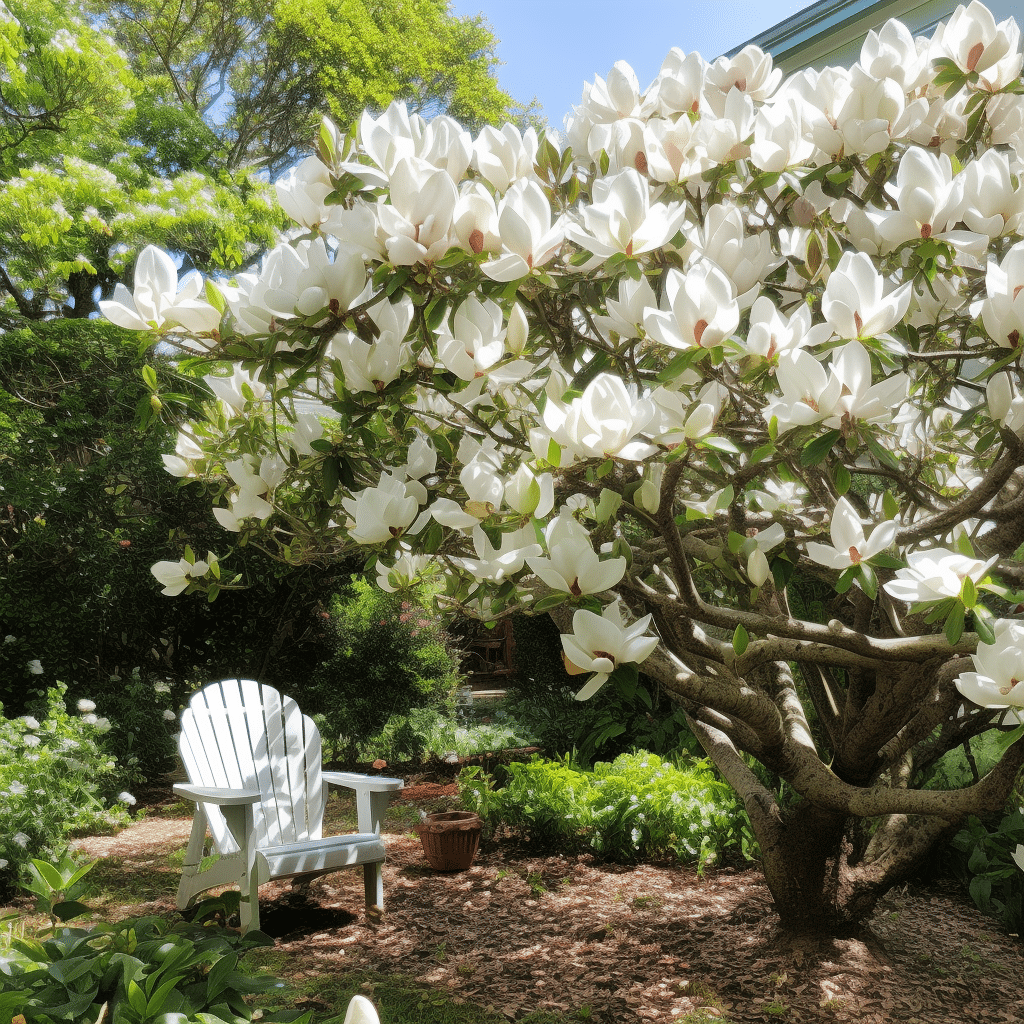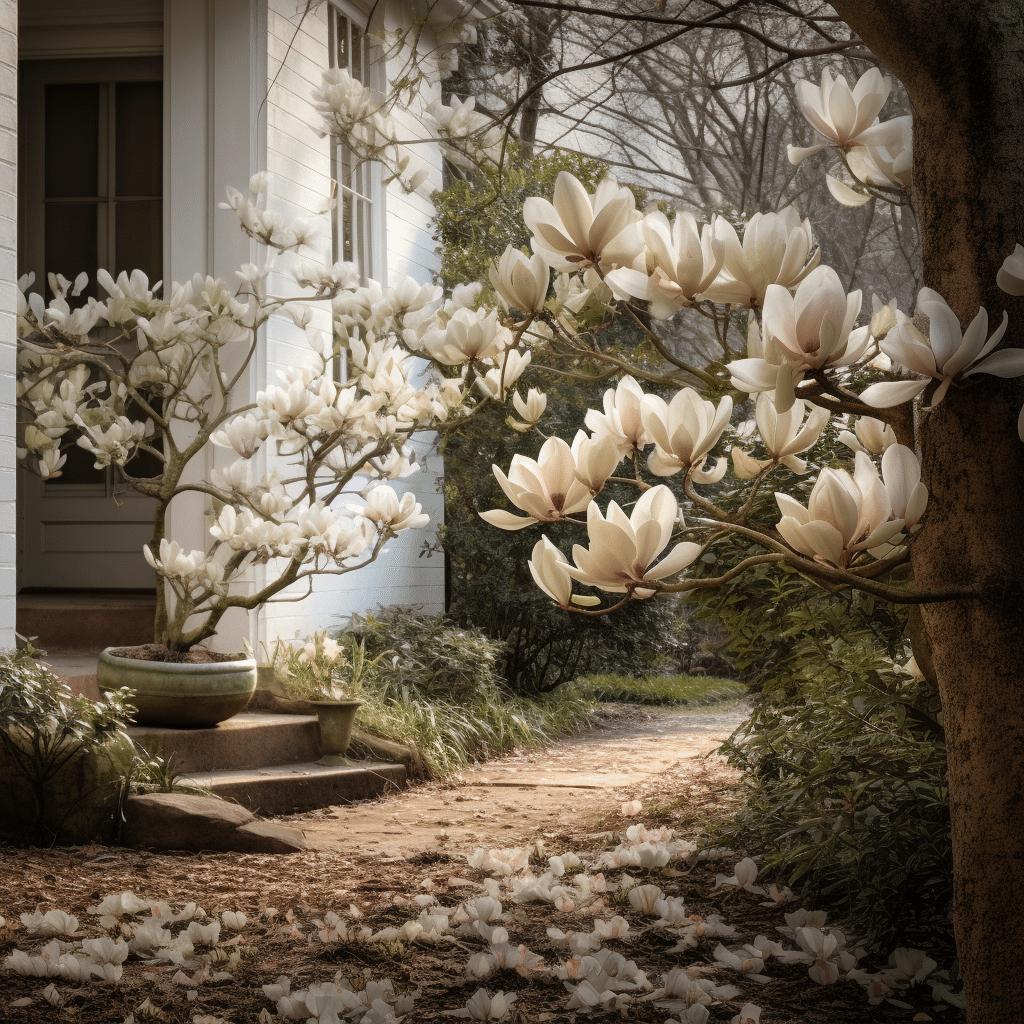
Yes, you can grow magnolia trees in Ontario. Magnolias are known for their stunning flowers and fragrance, making them a popular addition to gardens across North America. While magnolias are typically associated with warmer climates, there are several varieties that can thrive in Ontario’s cooler climate.
One of the most popular magnolia trees for Ontario is the Star Magnolia (Magnolia stellata). This tree is known for its beautiful early blooms, which are large and fragrant. Another option is the Saucer Magnolia, which is a hybrid of the Yulan or Chinese magnolia and the lily magnolia. This small tree can grow up to 30 feet tall and produces beautiful flowers in the spring.
If you’re considering growing a magnolia tree in Ontario, it’s important to choose a variety that is well-suited to the climate. While some magnolias may struggle in colder temperatures, there are several options that can thrive in Ontario’s climate. With the right care and attention, a magnolia tree can be a beautiful and long-lasting addition to any garden in Ontario.
Understanding Magnolias

Magnolia stellata
Magnolias are a genus of trees and shrubs that are known for their beautiful and fragrant flowers. There are over 200 species of magnolias, and they are found in various parts of the world, including North America, Asia, and South America.
Magnolias are typically classified as trees, but some species can also be classified as shrubs. The size of a magnolia tree can vary greatly, with some species growing to be small trees, while others can grow to be large shrubs.
One of the most well-known species of magnolias is the Magnolia grandiflora, also known as the southern magnolia. This tree is native to the southeastern United States and is known for its large, fragrant flowers and glossy leaves.
Another popular species of magnolia is the star magnolia (Magnolia stellata). This tree is a multi-stemmed deciduous shrub that is known for its early blooming and fragrant blossoms.
There are also several other species of magnolias that can be grown in Ontario, including the Magnolia virginiana, cucumber tree magnolia (Magnolia acuminata), lily magnolia, yulan magnolia, and sweetbay magnolia.
When it comes to growing magnolias in Ontario, it’s important to consider the climate and soil conditions. Magnolias generally prefer well-drained soil that is rich in organic matter and slightly acidic. They also require full sun to partial shade and protection from strong winds.
In terms of maintenance, magnolias are relatively low-maintenance trees and shrubs. They do require regular watering, especially during dry periods, and may benefit from occasional pruning to remove dead or damaged branches.
Overall, magnolias are a beautiful and fragrant addition to any garden or landscape. With the right growing conditions and care, they can thrive in Ontario and provide years of enjoyment for homeowners and gardeners alike.
Magnolia Varieties Suitable for Ontario

Magnolia trees are known for their stunning flowers and striking foliage, making them a popular choice for gardeners across the world. While some varieties of magnolia trees may not be suitable for Ontario’s climate, there are a few cold-hardy species that can thrive in this region.
One of the most popular magnolia trees for Ontario is the Star Magnolia (Magnolia stellata). This species is considered one of the best magnolia trees for the Toronto climate and is known for its huge, fragrant blossoms. Another excellent option is Magnolia stellata ‘Royal Star,’ a dense multi-stemmed deciduous shrub with an upright spreading habit of growth.
Saucer Magnolia (Magnolia x soulangeana) is another popular choice for Ontario gardens. This tree produces cup-shaped flowers that are creamy white, flushed with pink and purple. It is important to note that Saucer Magnolia may not grow well east of Peterborough or north of Owen Sound.
If you prefer taller magnolia trees, consider the hybrid magnolia called ‘Merrill.’ This tree can grow up to 30 feet tall and produces large, fragrant white flowers in the spring.
It is important to choose magnolia varieties that are suitable for your hardiness zone. Ontario is divided into various USDA plant hardiness zones, ranging from zone 5a to 7a. Magnolia trees that are suitable for zone 5a include Star Magnolia, Saucer Magnolia, and Merrill Magnolia.
In conclusion, there are several magnolia varieties that are suitable for Ontario’s climate. When choosing a magnolia tree, make sure to select a species that is appropriate for your hardiness zone. With proper care and attention, magnolia trees can add beauty and elegance to any garden in Ontario.
Planting Magnolia Trees in Ontario

Lily magnolia
Magnolia trees are a beautiful addition to any garden, and they can be grown in Ontario. Here are some tips for planting and caring for magnolia trees in Ontario.
Soil and Planting
Magnolias grow best in moist, well-drained soil that is rich in organic matter. They prefer slightly acidic soil with a pH between 5.0 and 6.5. If your soil is too alkaline, you can add sulfur to lower the pH. If your soil is heavy clay, it is a good idea to amend it with organic matter to improve drainage.
When planting a magnolia tree, choose a location with full sun or partial shade. Dig a hole that is twice as wide as the root ball and just as deep. Mix some compost or other organic matter into the soil to improve its structure and fertility. Place the tree in the hole, making sure that the top of the root ball is level with the surrounding soil. Fill in the hole with soil and tamp it down gently.
Potted Magnolias
Magnolias can also be grown in pots, which is a good option if you have limited space or want to move the tree around. Choose a pot that is at least 2 feet wide and has drainage holes in the bottom. Fill the pot with a good quality potting mix that is rich in organic matter and has good drainage. Plant the magnolia tree at the same depth as it was in its original container, and water it well.
Transplanting
If you need to transplant a magnolia tree, it is best to do it in the spring before new growth begins. Dig a hole that is at least twice as wide as the root ball and just as deep. Carefully remove the tree from its original location, taking care not to damage the roots. Place the tree in the new hole and fill in with soil, making sure that the top of the root ball is level with the surrounding soil. Water the tree well and mulch around the base to help retain moisture.
Maintenance
Magnolias need regular watering, especially during dry spells. Mulching around the base of the tree can help to retain moisture and suppress weeds. Fertilize the tree in the spring with a balanced fertilizer that is formulated for trees and shrubs. Prune the tree as needed to remove dead or damaged branches, and to shape it if desired.
By following these tips, you can enjoy the beauty of magnolia trees in your Ontario garden or on your patio.
Caring for Magnolia Trees
Magnolia trees are beautiful and majestic, but they require proper care to thrive in Ontario’s climate. Here are some tips on how to care for your magnolia tree:
Watering
Magnolia trees need regular watering, especially during dry spells. Water the tree deeply once a week, making sure the soil around the base of the tree is moist. Avoid overwatering, as this can lead to root rot.
Fertilizer
Magnolia trees benefit from regular fertilization. Use a slow-release fertilizer in the spring and fall to provide the tree with the nutrients it needs to grow and thrive.
Mulching
Mulching around the base of the magnolia tree can help retain moisture and regulate soil temperature. Use a layer of organic mulch, such as shredded bark or leaves, and avoid piling it up against the trunk of the tree.
Pruning
Prune your magnolia tree in late winter or early spring before new growth appears. Remove any dead or damaged branches, as well as any branches that are crossing or rubbing against each other. Avoid pruning too much, as this can lead to a reduction in flowering.
Sunlight and Temperature
Magnolia trees prefer full sun to partial shade. They can tolerate a range of temperatures, but they may suffer damage in extreme cold or heat. Protect your magnolia tree from strong winds, which can damage the delicate branches.
Humidity and pH
Magnolia trees prefer a humid environment and a slightly acidic soil with a pH between 5.0 and 6.5. If your soil is too alkaline, you can lower the pH by adding sulfur or other acidifying agents.
Magnolia Tree Characteristics
Magnolia trees are a popular choice among gardeners due to their stunning blooms and attractive foliage. They are deciduous or evergreen trees with oval-shaped, glossy leaves that can be fuzzy or reddish in color. Magnolia trees are known for their fragrant, showy flowers that come in a range of colors, including white, pink, purple, and yellow. The flowers can be either single or double blooms, and they typically appear in early spring before the leaves emerge.
One of the most popular varieties of magnolia trees is the Southern magnolia (Magnolia grandiflora), which is an evergreen tree that produces large, fragrant, white blooms. Another popular variety is the saucer magnolia (Magnolia x soulangeana), which is a deciduous tree that produces large, pink flowers with white interiors. The yellow bird magnolia (Magnolia ‘Yellow Bird’) is a deciduous tree that produces fragrant, yellow flowers.
Magnolia trees are native to Asia and the Americas, and they are commonly referred to as flowering trees. They are known for their rapid growth rate and can reach a mature height of up to 80 feet, depending on the variety. Magnolia trees are disease-free and can tolerate wet feet, making them an ideal choice for areas with high humidity or wet soil conditions.
In conclusion, magnolia trees are a beautiful addition to any garden due to their stunning blooms and attractive foliage. They come in a range of colors and varieties, including white, pink, purple, and yellow, and can be either deciduous or evergreen. Magnolia trees are disease-free, grow rapidly, and can tolerate wet feet, making them a popular choice among gardeners.
Special Considerations for Ontario’s Climate
When it comes to growing magnolia trees in Ontario, there are a few special considerations to keep in mind. Magnolia trees are typically native to warmer climates, which means they may not thrive in Ontario’s colder climate. However, with careful planning and attention to detail, it is possible to grow magnolia trees in Ontario.
Timing
One of the most important considerations for growing magnolia trees in Ontario is timing. Magnolia trees typically bloom in the spring, which means they are vulnerable to late spring frosts. This can damage or kill the tree, so it is important to choose a variety that is hardy enough to withstand Ontario’s climate.
Variety
When choosing a magnolia tree to grow in Ontario, it is important to select a variety that is hardy enough to survive in colder climates. Some of the best varieties for Ontario include the star magnolia, saucer magnolia, and cucumber tree magnolia. These varieties are hardy enough to withstand Ontario’s climate and will thrive with proper care and attention.
Location
Another important consideration when growing magnolia trees in Ontario is location. Magnolia trees prefer well-drained soil and full sun, so it is important to choose a location that meets these requirements. Additionally, it is important to choose a location that is sheltered from the wind, as magnolia trees can be vulnerable to wind damage.
Care
Proper care is essential for growing magnolia trees in Ontario. This includes regular watering, fertilizing, and pruning. It is also important to protect the tree from pests and diseases, which can be a problem in Ontario’s climate.
Overall, while growing magnolia trees in Ontario may require some extra care and attention, it is possible to grow these beautiful trees in this climate. With the right variety, location, and care, magnolia trees can thrive in Ontario’s climate and provide a stunning addition to any garden or landscape.
Conclusion
In conclusion, growing magnolia trees in Ontario can be a challenge due to the harsh winters, but it is possible to cultivate certain species successfully. It is important to choose the right species, such as the cucumber tree or the little gem, which are native to the area and can withstand the cold climate.
When planting magnolia trees, it is essential to provide them with well-draining soil and adequate water. These trees prefer slightly acidic soil that is rich in organic matter. They also require full sun or partial shade to thrive.
If you are looking for a fragrant magnolia tree, consider the yellow magnolia, which produces beautiful yellow flowers with a lemony scent. Hybrid magnolia trees, such as the saucer magnolia, are also popular in Ontario and can add a touch of elegance to any landscape.
Overall, magnolia trees are a great addition to any garden or landscape, and with proper care and attention, they can thrive in Ontario’s climate. Whether you are looking for a beautiful shrub or a stunning tree, there is a magnolia species that will suit your needs.
Colin Macmillan is a seasoned entrepreneur and the CEO of Riverwood Landscape, a leading landscaping company based in Canada. He has been at the helm of the company since leaving high school, demonstrating his strong leadership skills and business acumen.
Colin’s expertise lies in various aspects of landscaping, including lawn care, interlocking, sod installation, and commercial maintenance. His hands-on approach and dedication to the craft have been instrumental in building Riverwood Landscape into a reputable brand.
One of his most notable achievements is the creation of a successful landscape franchise that services multiple locations. This accomplishment underscores his strategic thinking and ability to scale operations effectively.
Colin has also had the privilege of working with Guelph Hospital for landscaping and maintenance, a testament to the trust and reliability that his company has earned over the years.
His professional mission is to offer the best services and experiences for customers, a goal that he tirelessly pursues. Colin’s commitment to excellence and customer satisfaction continues to drive the growth and success of Riverwood Landscape.








